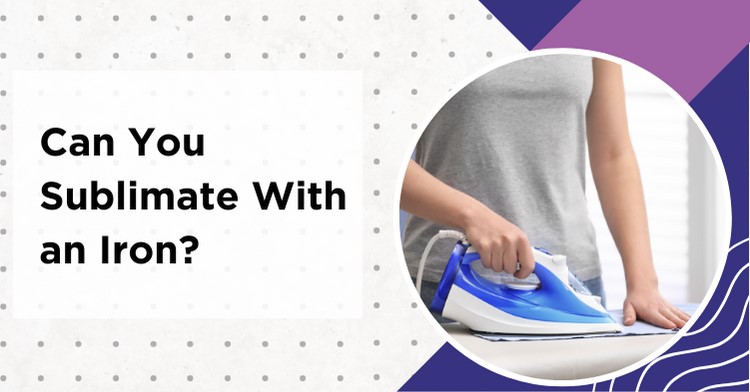Can you sublimate with an iron? The answer is yes, but I do not recommend doing so. In this blog post, we’ll go over everything that you need to know about sublimating with an iron.
We’ll cover if you can use an iron or not and what are the differences between iron and heat press sublimation. By the end of this post, you’ll be confident enough about whether using iron for sublimation is good or not.
Can you sublimate with an iron?
Yes, you can use an Iron for sublimation, however, it is not recommended as the varied temperature and lack of constant pressure can spoil the prints. Also, there are many chances of Ghosting.Why an Iron can’t be used for sublimation
Though iron can be used it lacks basically two features that are very vital for perfect sublimation.
1. Precise Temperature Control
During sublimation, you need to make sure that the temperature is set up correctly. You’ll want to make sure the temperature is set between 350 and 400 degrees Fahrenheit, depending on the material you’re sublimating.
Iron can reach a temperature of up to 440 degrees Fahrenheit but it does not allow you to control it precisely and this is the most important aspect of sublimation.
You need a constant temperature for a limited time period say 60 seconds or 90 seconds.
Also, some irons have a stand-by mode that automatically turns off after 10-15 minutes. So overall, there is not a constant temperature, it changes frequently. So, this is first the reason, you can’t use iron for sublimation.
2. Pressure Settings
With an Iron, there is no option for pressure settings. You have to apply it by yourself, which can vary.
After a static temperature, sublimation also requires a constant pressure spread uniformly over the print area, so the ink gets transferred completely without any shadows or ink spots.
Therefore, due to a lack of uniform pressure, iron can’t be used for sublimation.
Why Heat Press is best for sublimation?
Heat press for sublimation is an excellent choice for those looking to create personalized items with long-lasting, vibrant colors. It allows you to transfer designs onto a wide variety of hard surfaces including metals, ceramic mugs and plates, mouse pads, and more.
With heat press, you get sharpness and detail in your images that are not available with iron.
Additionally, the colors remain vibrant through multiple washes and do not fade or become discolored over time.
Heat press machines are easier to operate, making them much more efficient and cost-effective. With a wide range of temperature settings available, you can customize the temperature to suit whatever type of material you’re working with.
Not only that, but it also provides a constant pressure that is spread uniformly over the substrate.
Heat press machines also provide quick production times so that you can quickly create high-quality products in bulk quantities quickly and efficiently.
Read our detailed guide on choosing the best heat presses.
Pros and cons of using an iron for sublimation
Pros
One of the main advantages of using iron for sublimation is that it is relatively cost-effective. An iron is inexpensive to purchase and does not require any special or expensive equipment or tools to use.
Another benefit of using iron for sublimation is that it can help make custom products more easily available to individuals and businesses.
Since no specialty equipment is required, more people have access to personalization capabilities by creating custom shirts, mugs, hats, bags, etc. at home or in small business settings without needing advanced technical skills or expensive setup costs.
Cons
The main downside of using iron for sublimation is that it typically produces lower-quality results than a heat press. As stated before, while a skilled user may be able to get decent results with an iron they are usually limited in terms of detail level compared to other more advanced techniques.
Also, since irons are not designed specifically for sublimation pressing tasks their performance tends to be inconsistent from one design to another which can lead to uneven results from one print run to another.
Additionally, the improper pressing technique can also result in unwanted smudging or cracking which would ruin a printed design if care isn’t taken when applying pressure with the heated element.
Another disadvantage of using an iron for sublimation is the possibility of damaging your printed materials due to incorrect temperature settings during pressing operations.
The temperature required depends on the specific material being used so users should take care when adjusting them as too high a setting can scorch your garments resulting in poor quality prints and wasted effort.
FAQ’s
How do you iron on sublimation prints?
To iron on sublimation prints, cover the print with a thin cloth or parchment paper. Use a hot iron (around 375°F or 190°C) to press the print for 20-30 seconds with even pressure. At the end let it cool and then you can remove the protective paper to keep the print intact.
How long do you iron on sublimation?
Best to iron on sublimation for about 20-30 seconds. For this, you have to use a hot iron (around 375°F or 190°C) and press even on it. Let it cool before removing the protective paper.
Can you iron sublimation on cotton?
No, sublimation works best on polyester fabrics as it bonds with the synthetic fibers. Cotton doesn’t have the same receptive properties, so sublimation won’t adhere well, and the print may not be vibrant or lasting. It’s recommended to choose polyester or a blend for effective sublimation results.
Do you have to have a heat press to do sublimation?
While a heat press is commonly used for sublimation, you can also use a regular household iron. Just make sure to set it at the recommended temperature for sublimation (around 375°F or 190°C) and apply even pressure. A heat press provides more consistency, but an iron can work for smaller projects.
Conclusion
Overall, sublimating with iron is possible, but it is not recommended.
While you may be able to get away with using an iron, there are some risks associated with doing so. The best way to avoid those risks is to invest in a heat press machine specifically designed for sublimation.
If you decide to use an iron, make sure that you keep a close eye on it and test it on a scrap piece of fabric before moving on to your final project.

Emily loves making things special.
She’s also a mom and a wife who enjoys crafting and runs a small business from her home. She knows that the little things can make a house feel like a warm and loving home. This belief has led her to explore the exciting world of sublimation, a crafty way to add a personal touch to just about anything. Her website shares valuable information about sublimation, her crafty ideas, and tips.


